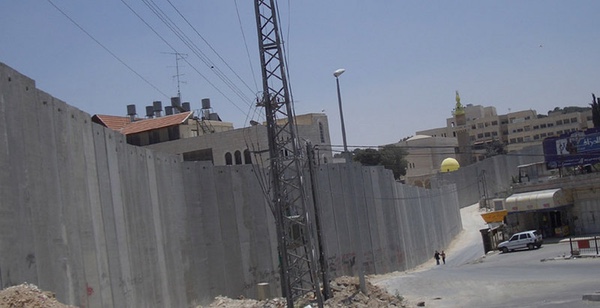Trump Ridiculously Compares His Big Wall on the Mexican Border with the West Bank Barrier in Israel

The barrier between Abu Dis and East Jerusalem, June 2004, By Zero0000 at the English language Wikipedia, CC BY-SA 3.0
Presidential candidate Donald Trump met with Israeli Prime Minister Benjamin Netanyahu on Sunday at Trump Tower in Manhattan and doubled down on his promise to build a big, beautiful wall along the United States-Mexico border. He compared his envisioned project to Israel’s West Bank barrier, which was once a fence and has since been converted into a wall. Israelis generally view the wall as a necessary deterrent to terrorism, but Palestinians have often characterized it as a symbol of “apartheid.”
Comparing the U.S.-Mexico border to the Israeli-Palestinian divide, as Trump as essentially done, is highly problematic for two reasons. First, it does not take into account the historical differences between the two border areas. And second, it creates a problem where there really is not one.
The U.S.-Mexico border that exists today is roughly the same one that was established in the aftermath of the Mexican-American war in the 1840s. The U.S. seized what are now the western States from Mexico, and a clear boundary was drawn from where the Rio Grande flows in Texas all the way to the Pacific. The U.S. and Mexico have not fought a war since, and most Americans do not fear Mexican attacks on their soil, despite concerns about illegal immigration and drug trafficking.
In contrast, the Israeli-Palestinian borders have shifted significantly since the creation of the state of Israel in 1948. Several wars have been fought and Israel has occupied and relinquished territories in the process. The wall along the West Bank boundary was built in 2002 in response to the second Palestinian intifada (“uprising”), a spasm of violence which cost the lives of hundreds of civilians on both sides. Israeli citizens have lived with a nearly constant fear of Palestinian terrorism since the 1970s, and Palestinians have had to suffer brutal reprisals by the Israeli military.
Although the U.S.-Mexico divide and the Israeli-Palestinian impasse do not warrant serious historical comparisons, it is not unreasonable to assert that the border between the U.S. and its southern neighbor does pose some serious problems. It is much larger and vaster frontier than the one that divides Israel and the West Bank, and thus provides more hospitable territory for the movement of people. Since the 1940s, American employers have encouraged Mexican workers (both legal and illegal) to cross the border and do manual labor that Americans supposedly will not do. This has benefitted both the U.S. and Mexico, providing much-needed cheap labor for American farmers and builders while alleviating some of the glaring income inequality that has existed in Mexico for decades. The creation of the Border Industrialization Program in the mid-1960s further provided the legal framework for American businesses to employ Mexicans at a low cost, this time on the Mexican side of the border. American-owned factories, or maquiladoras, have proliferated throughout the border region in the past several decades. But as Americans have seen their communities hemorrhage jobs (many of which have gone to Mexico) and have seen illegal narcotics (much of which are from Mexico) flood their neighborhoods, they have become increasingly skeptical of Washington’s close economic partnership with Mexico City.
American policymakers have long called for an open border with Mexico. Arizona Senator Barry Goldwater, in a 1962 editorial for the Tucson Daily Citizen,imagined a frontier free of “red tape” where Americans and Mexicans could travel back and forth unencumbered. Since then, American and Mexican leaders have cooperated on national security and economic matters quite consistently. Mexico remains America’s third largest trading partner, despite the fact that the issues of drug trafficking and illegal immigration have put a strain on this relationship in the past several decades. Israel and its Palestinian neighbors have achieved nothing of the kind of rapport that the U.S. and Mexico have. The sheer fact that the Palestinians cannot claim their own state makes the comparison with the U.S.-Mexico situation highly dubious. The U.S. and Mexico have their work cut out for them in solving the problems of immigration and drug trafficking, but this will not require building a wall and, in effect, acknowledging that a state of conflict exists where it really does not. Mr. Trump should be more careful when making such historically and factually problematic suggestions.